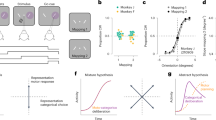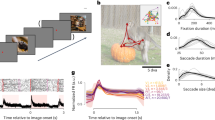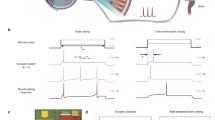Abstract
Visual stimuli are known to vary in their perceived duration. Some visual stimuli are also known to linger for longer in memory. Yet, whether these two features of visual processing are linked is unknown. Despite early assumptions that time is an extracted or higher-order feature of perception, more recent work over the past two decades has demonstrated that timing may be instantiated within sensory modality circuits. A primary location for many of these studies is the visual system, where duration-sensitive responses have been demonstrated. Furthermore, visual stimulus features have been observed to shift perceived duration. These findings suggest that visual circuits mediate or construct perceived time. Here we present evidence across a series of experiments that perceived time is affected by the image properties of scene size, clutter and memorability. More specifically, we observe that scene size and memorability dilate time, whereas clutter contracts it. Furthermore, the durations of more memorable images are also perceived more precisely. Conversely, the longer the perceived duration of an image, the more memorable it is. To explain these findings, we applied a recurrent convolutional neural network model of the ventral visual system, in which images are progressively processed over time. We find that more memorable images are processed faster, and that this increase in processing speed predicts both the lengthening and the increased precision of perceived durations. These findings provide evidence for a link between image features, time perception and memory that can be further explored with models of visual processing.
This is a preview of subscription content, access via your institution
Access options
Access Nature and 54 other Nature Portfolio journals
Get Nature+, our best-value online-access subscription
$29.99 / 30 days
cancel any time
Subscribe to this journal
Receive 12 digital issues and online access to articles
$119.00 per year
only $9.92 per issue
Buy this article
- Purchase on Springer Link
- Instant access to full article PDF
Prices may be subject to local taxes which are calculated during checkout





Similar content being viewed by others
Data availability
All behavioural data for these experiments, as well as the rCNN results and memorability images used, are available at https://doi.org/10.17605/OSF.IO/FX3N2 (ref. 96).
Code availability
All relevant toolboxes and code repositories are cited in the text. The code is available at https://doi.org/10.17605/OSF.IO/FX3N2 (ref. 96).
References
van Wassenhove, V. Minding time in an amodal representational space. Phil. Trans. R. Soc. B 364, 1815–1830 (2009).
Yu, Q. et al. Visual cortex encodes timing information in humans and mice. Neuron 110, 4194–4211.e10 (2022).
Gibbon, J., Church, R. M. & Meck, W. H. Scalar timing in memory. Ann. N. Y. Acad. Sci. 423, 52–77 (1984).
Block, R. A. & Zakay, D. Prospective and retrospective duration judgments: a meta-analytic review. Psychon. Bull. Rev. 4, 184–197 (1997).
Matthews, W. J. & Meck, W. H. Temporal cognition: connecting subjective time to perception, attention, and memory. Psychol. Bull. 142, 865–907 (2016).
Tse, P. U., Intriligator, J., Rivest, J. & Cavanagh, P. Attention and the subjective expansion of time. Percept. Psychophys. 66, 1171–1189 (2004).
Walsh, V. A theory of magnitude: common cortical metrics of time, space and quantity. Trends Cogn. Sci. 7, 483–488 (2003).
Eagleman, D. M. & Pariyadath, V. Is subjective duration a signature of coding efficiency? Phil. Trans. R. Soc. B 364, 1841–1851 (2009).
Aaen-Stockdale, C., Hotchkiss, J., Heron, J. & Whitaker, D. Perceived time is spatial frequency dependent. Vis. Res. 51, 1232–1238 (2011).
Bruno, A. & Cicchini, G. M. Multiple channels of visual time perception. Curr. Opin. Behav. Sci. 8, 131–139 (2016).
Matthews, W. J., Stewart, N. & Wearden, J. H. Stimulus intensity and the perception of duration. J. Exp. Psychol. Hum. Percept. Perform. 37, 303–313 (2011).
Allman, M. J., Teki, S., Griffiths, T. D. & Meck, W. H. Properties of the internal clock: first- and second-order principles of subjective time. Annu. Rev. Psychol. 65, 743–771 (2014).
Wang, L. & Jiang, Y. Life motion signals lengthen perceived temporal duration. Proc. Natl Acad. Sci. USA 109, E673–E677 (2012).
Lake, J. I., LaBar, K. S. & Meck, W. H. Emotional modulation of interval timing and time perception. Neurosci. Biobehav. Rev. 64, 403–420 (2016).
Varakin, D. A., Klemes, K. J. & Porter, K. A. The effect of scene structure on time perception. Q. J. Exp. Psychol. (Hove) 66, 1639–1652 (2013).
Palumbo, L., Ogden, R., Makin, A. D. & Bertamini, M. Examining visual complexity and its influence on perceived duration. J. Vis. 14, 3 (2014).
Shuler, M. G. & Bear, M. F. Reward timing in the primary visual cortex. Science 311, 1606–1609 (2006).
Namboodiri, V. M., Huertas, M. A., Monk, K. J., Shouval, H. Z. & Hussain, S. M. G. Visually cued action timing in the primary visual cortex. Neuron 86, 319–330 (2015).
Bueti, D., Bahrami, B., Walsh, V. & Rees, G. Encoding of temporal probabilities in the human brain. J. Neurosci. 30, 4343–4352 (2010).
Heron, J. et al. Duration channels mediate human time perception. Proc. R. Soc. B 279, 690–698 (2012).
Noguchi, Y. & Kakigi, R. Time representations can be made from nontemporal information in the brain: an MEG study. Cereb. Cortex 16, 1797–1808 (2006).
Heron, J., Hotchkiss, J., Aaen-Stockdale, C., Roach, N. W. & Whitaker, D. A neural hierarchy for illusions of time: duration adaptation precedes multisensory integration. J. Vis. 13, 4 (2013).
Heron, J., Fulcher, C., Collins, H., Whitaker, D. & Roach, N. W. Adaptation reveals multi-stage coding of visual duration. Sci. Rep. 9, 3016 (2019).
Bueti, D. & Macaluso, E. Auditory temporal expectations modulate activity in visual cortex. NeuroImage 51, 1168–1183 (2010).
Cicchini, G. M. Perception of duration in the parvocellular system. Front. Integr. Neurosci. 6, 14 (2012).
Suárez-Pinilla, M., Nikiforou, K., Fountas, Z., Seth, A. K. & Roseboom, W. Perceptual content, not physiological signals, determines perceived duration when viewing dynamic, natural scenes. Collabra Psychol. 5, 55 (2019).
Cardaci, M., Tabacchi, M. E., Petrou, M. & Gesù, V. D. Attentional vs computational complexity measures in observing paintings. Spat. Vis. 22, 195–209 (2009).
Folta-Schoofs, K., Wolf, O. T., Treue, S. & Schoofs, D. Perceptual complexity, rather than valence or arousal accounts for distracter-induced overproductions of temporal durations. Acta Psychol. (Amst.) 147, 51–59 (2014).
Huertas, M. A., Hussain, S. M. G. & Shouval, H. Z. A simple network architecture accounts for diverse reward time responses in primary visual cortex. J. Neurosci. 35, 12659–12672 (2015).
Park, S., Konkle, T. & Oliva, A. Parametric coding of the size and clutter of natural scenes in the human brain. Cereb. Cortex 25, 1792–1805 (2015).
Moscatelli, A., Mezzetti, M. & Lacquaniti, F. Modeling psychophysical data at the population-level: the generalized linear mixed model. J. Vis. 12, 26 (2012).
Khosla, A., Raju, A. S., Torralba, A. & Oliva, A. Understanding and predicting image memorability at a large scale. In 2015 IEEE International Conference on Computer Vision (ICCV) 2390–2398 (IEEE, 2015).
Rust, N. C. & Mehrpour, V. Understanding image memorability. Trends Cogn. Sci. 24, 557–568 (2020).
Gedvila, M., Ongchoco, J. D. K. & Bainbridge, W. A. Memorable beginnings, but forgettable endings: intrinsic memorability alters our subjective experience of time. Vis. Cogn. 31, 380–389 (2023).
Potter, M. C. & Levy, E. I. Recognition memory for a rapid sequence of pictures. J. Exp. Psychol. 81, 10–15 (1969).
Potter, M. C. Recognition and memory for briefly presented scenes. Front. Psychol. 3, 32 (2012).
Wichmann, F. A., Sharpe, L. T. & Gegenfurtner, K. R. The contributions of color to recognition memory for natural scenes. J. Exp. Psychol. Learn. Mem. Cogn. 28, 509–520 (2002).
Jazayeri, M. & Shadlen, M. N. Temporal context calibrates interval timing. Nat. Neurosci. 13, 1020–1026 (2010).
Remington, E. D., Parks, T. V. & Jazayeri, M. Late Bayesian inference in mental transformations. Nat. Commun. 9, 4419 (2018).
De Kock, R., Zhou, W., Joiner, W. M. & Wiener, M. Slowing the body slows down time perception. eLife 10, e63607 (2021).
De Kock, R., Zhou, W., Datta, P., Mychal, J. W. & Wiener, M. The role of consciously timed movements in shaping and improving auditory timing. Proc. R. Soc. B 290, 20222060 (2023).
Brown, S. W. Attentional resources in timing: interference effects in concurrent temporal and nontemporal working memory tasks. Percept. Psychophys. 59, 1118–1140 (1997).
Isola, P., Jianxiong, X., Parikh, D., Torralba, A. & Oliva, A. What makes a photograph memorable? IEEE Trans. Pattern Anal. Mach. Intell. 36, 1469–1482 (2014).
Bainbridge, W. A. The resiliency of image memorability: a predictor of memory separate from attention and priming. Neuropsychologia 141, 107408 (2020).
Wakeland-Hart, C. D., Cao, S. A., deBettencourt, M. T., Bainbridge, W. A. & Rosenberg, M. D. Predicting visual memory across images and within individuals. Cognition 227, 105201 (2022).
Schrimpf, M. et al. Integrative benchmarking to advance neurally mechanistic models of human intelligence. Neuron 108, 413–423 (2020).
Saxe, A., Nelli, S. & Summerfield, C. If deep learning is the answer, what is the question? Nat. Rev. Neurosci. 22, 55–67 (2020).
Praveen, A. et al. ResMem-Net: memory based deep CNN for image memorability estimation. PeerJ Comput. Sci. 7, e767 (2021).
van Bergen, R. S. & Kriegeskorte, N. Going in circles is the way forward: the role of recurrence in visual inference. Curr. Opin. Neurobiol. 65, 176–193 (2020).
Spoerer, C. J., Kietzmann, T. C., Mehrer, J., Charest, I. & Kriegeskorte, N. Recurrent neural networks can explain flexible trading of speed and accuracy in biological vision. PLoS Comput. Biol. 16, e1008215 (2020).
Karapetian, A. et al. Empirically identifying and computationally modeling the brain–behavior relationship for human scene categorization. J. Cogn. Neurosci. 35, 1879–1897 (2023).
Sörensen, L. K. A., Bohté, S. M., de, J. D., Slagter, H. A. & Scholte, H. S. Mechanisms of human dynamic object recognition revealed by sequential deep neural networks. PLoS Comput. Biol. 19, e1011169 (2023).
Bueti, D. & Walsh, V. The parietal cortex and the representation of time, space, number and other magnitudes. Phil. Trans. R. Soc. B 364, 1831–1840 (2009).
Manassi, M. & Whitney, D. Multi-level crowding and the paradox of object recognition in clutter. Curr. Biol. 28, R127–R133 (2018).
Martin, C. R., Khosla, A., Pantazis, D. & Oliva, A. Dynamics of scene representations in the human brain revealed by magnetoencephalography and deep neural networks. NeuroImage 153, 346–358 (2017).
Graumann, M., Ciuffi, C., Dwivedi, K., Roig, G. & Cichy, R. M. The spatiotemporal neural dynamics of object location representations in the human brain. Nat. Hum. Behav. 6, 796–811 (2022).
Vishne, G., Gerber, E. M., Knight, R. T. & Deouell, L. Y. Distinct ventral stream and prefrontal cortex representational dynamics during sustained conscious visual perception. Cell Rep. 42, 112752 (2023).
Learmonth, A. E., Nadel, L. & Newcombe, N. S. Children’s use of landmarks: implications for modularity theory. Psychol. Sci. 13, 337–341 (2002).
Bonner, M. F. & Epstein, R. A. Coding of navigational affordances in the human visual system. Proc. Natl Acad. Sci. USA 114, 4793–4798 (2017).
Josephs, E. L. & Konkle, T. Large-scale dissociations between views of objects, scenes, and reachable-scale environments in visual cortex. Proc. Natl Acad. Sci. USA 117, 29354–29362 (2020).
Riemer, M., Shine, J. P. & Wolbers, T. On the (a)symmetry between the perception of time and space in large-scale environments. Hippocampus 28, 539–548 (2018).
Davis, T. M. & Bainbridge, W. A. Memory for artwork is predictable. Proc. Natl Acad. Sci. USA 120, e2302389120 (2023).
Dubey, R., Peterson, J., Khosla, A., Yang, M.-H. & Ghanem, B. What makes an object memorable? In 2015 IEEE International Conference on Computer Vision (ICCV) 1089–1097 (IEEE, 2015).
Jaegle, A. et al. Population response magnitude variation in inferotemporal cortex predicts image memorability. eLife 8, e47596 (2019).
Masarwa, S., Kreichman, O. & Gilaie-Dotan, S. Larger images are better remembered during naturalistic encoding. Proc. Natl Acad. Sci. USA 119, e2119614119 (2022).
Jeong, S. K. Perceived image size modulates visual memory. Psychon. Bull. Rev. 30, 2282–2288 (2023).
Pooresmaeili, A., Arrighi, R., Biagi, L. & Morrone, M. C. Blood oxygen level-dependent activation of the primary visual cortex predicts size adaptation illusion. J. Neurosci. 33, 15999–16008 (2013).
Rust, N. C. & Cohen, M. R. Priority coding in the visual system. Nat. Rev. Neurosci. 23, 376–388 (2022).
Rust, N. C. & Palmer, S. E. Remembering the past to see the future. Annu. Rev. Vis. Sci. 7, 349–365 (2021).
White, P. A. The three-second subjective present: a critical review and a new proposal. Psychol. Bull. 143, 735–756 (2017).
Pereira, M., Perrin, D. & Faivre, N. A leaky evidence accumulation process for perceptual experience. Trends Cogn. Sci. 26, 451–461 (2022).
Ossmy, O. et al. The timescale of perceptual evidence integration can be adapted to the environment. Curr. Biol. 23, 981–986 (2013).
de Jong, J., van Rijn, H. & Akyürek, E. G. Adaptive encoding speed in working memory. Psychol. Sci. 34, 822–833 (2023).
Kietzmann, T. C. et al. Recurrence is required to capture the representational dynamics of the human visual system. Proc. Natl Acad. Sci. USA 116, 21854–21863 (2019).
Lamme, V. A. & Roelfsema, P. R. The distinct modes of vision offered by feedforward and recurrent processing. Trends Neurosci. 23, 571–579 (2000).
Goudar, V. & Buonomano, D. V. Encoding sensory and motor patterns as time-invariant trajectories in recurrent neural networks. eLife 7, e31134 (2018).
Bi, Z. & Zhou, C. Understanding the computation of time using neural network models. Proc. Natl Acad. Sci. USA 117, 10530–10540 (2020).
Wang, J., Narain, D., Hosseini, E. A. & Jazayeri, M. Flexible timing by temporal scaling of cortical responses. Nat. Neurosci. 21, 102–110 (2018).
Bainbridge, W. A., Isola, P. & Oliva, A. The intrinsic memorability of face photographs. J. Exp. Psychol. Gen. 142, 1323–1334 (2013).
Koch, G. E., Akpan, E. & Coutanche, M. N. Image memorability is predicted by discriminability and similarity in different stages of a convolutional neural network. Learn. Mem. 27, 503–509 (2020).
Han, S., Rezanejad, M. & Walther, D. B. Memorability of line drawings of scenes: the role of contour properties. Mem. Cogn. https://doi.org/10.3758/s13421-023-01478-4 (2023).
Gillies, G. et al. Tracing the emergence of the memorability benefit. Cognition 238, 105489 (2023).
Kramer, M. A., Hebart, M. N., Baker, C. I. & Bainbridge, W. A. The features underlying the memorability of objects. Sci. Adv. 9, eadd2981 (2023).
Conwell, C., Prince, J. S., Kay, K. N., Alvarez, G. A. & Konkle, T. What can 1.8 billion regressions tell us about the pressures shaping high-level visual representation in brains and machines? Preprint at bioRxiv https://doi.org/10.1101/2022.03.28.485868 (2022).
Goetschalckx, L. & Wagemans, J. MemCat: a new category-based image set quantified on memorability. PeerJ 7, e8169 (2019).
Willenbockel, V. et al. Controlling low-level image properties: the SHINE toolbox. Behav. Res. Methods 42, 671–684 (2010).
Kopec, C. D. & Brody, C. D. Human performance on the temporal bisection task. Brain Cogn. 74, 262–272 (2010).
Treutwein, B. Adaptive psychophysical procedures. Vis. Res. 35, 2503–2522 (1995).
Wichmann, F. A. & Hill, N. J. The psychometric function: I. Fitting, sampling, and goodness of fit. Percept. Psychophys. 63, 1293–1313 (2001).
Schütt, H. H., Harmeling, S., Macke, J. H. & Wichmann, F. A. Painfree and accurate Bayesian estimation of psychometric functions for (potentially) overdispersed data. Vis. Res. 122, 105–123 (2016).
Lapid, E., Ulrich, R. & Rammsayer, T. On estimating the difference limen in duration discrimination tasks: a comparison of the 2AFC and the reminder task. Percept. Psychophys. 70, 291–305 (2008).
Mioni, G., Stablum, F., McClintock, S. M. & Grondin, S. Different methods for reproducing time, different results. Atten. Percept. Psychophys. 76, 675–681 (2014).
O’brien, R. M. A caution regarding rules of thumb for variance inflation factors. Qual. Quant. 41, 673–690 (2007).
Doerig, A. et al. The neuroconnectionist research programme. Nat. Rev. Neurosci. 24, 431–450 (2023).
Mehrer, J., Spoerer, C. J., Jones, E. C., Kriegeskorte, N. & Kietzmann, T. C. An ecologically motivated image dataset for deep learning yields better models of human vision. Proc. Natl Acad. Sci. USA 118, e2011417118 (2021).
Wiener, M. Data and code for ‘Memorability shapes perceived time (and vice versa)’. OSF https://doi.org/10.17605/OSF.IO/FX3N2 (2024).
Acknowledgements
We thank A. Oliva, J. Ongchoco, T. Konkle and T. Kietzmann for their helpful comments relating to the stimuli, results and findings in this manuscript. The authors received no specific funding for this work.
Author information
Authors and Affiliations
Contributions
M.W., A.D.C. and A.C.M. conceived of and designed the experiments. A.D.C. and A.C.M. collected and analysed the data, with consultation and additional analyses by M.W. A.C.M. and M.W. wrote the manuscript.
Corresponding author
Ethics declarations
Competing interests
The authors declare no competing interests.
Peer review
Peer review information
Nature Human Behaviour thanks Luca Ronconi, Vishwa Goudar and Changsong Zhou for their contribution to the peer review of this work. Peer reviewer reports are available.
Additional information
Publisher’s note Springer Nature remains neutral with regard to jurisdictional claims in published maps and institutional affiliations.
Supplementary information
Rights and permissions
Springer Nature or its licensor (e.g. a society or other partner) holds exclusive rights to this article under a publishing agreement with the author(s) or other rightsholder(s); author self-archiving of the accepted manuscript version of this article is solely governed by the terms of such publishing agreement and applicable law.
About this article
Cite this article
Ma, A.C., Cameron, A.D. & Wiener, M. Memorability shapes perceived time (and vice versa). Nat Hum Behav (2024). https://doi.org/10.1038/s41562-024-01863-2
Received:
Accepted:
Published:
DOI: https://doi.org/10.1038/s41562-024-01863-2
This article is cited by
-
Your perception of time is skewed by what you see
Nature (2024)



